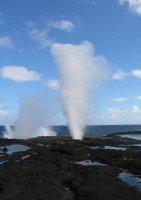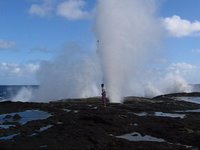 A few friends and I have just spent three (and a bit) days on Savaii touring around the island. It was great fun; we managed a complete lap of the island, seeing sights I'd never seen before, eating great food and catching up with friends.
A few friends and I have just spent three (and a bit) days on Savaii touring around the island. It was great fun; we managed a complete lap of the island, seeing sights I'd never seen before, eating great food and catching up with friends.After completing the hour ferry ride from 'Upolu to Savaii's port at Salelolga, our first port of call was the village of Palauli. There we collected Clair, a fellow Australian volunteer who works at a Marist school in the neighbouring village of Vailoa. From there we travelled about a mile or so up the road to stop off at the beautiful Olemoe waterfall. I've been to Olemoe before and like the last time, this visit didn't disappoint. Recent (unseasonally large) rainfall guaranteed that the waterfall was running at full steam. In her many visits, Clair hadn't seen it as powerful as it was on Saturday. The water was cold and very refreshing and the little freshwater prawns were nibbling our toes as we relaxed.
 After our swim we returned to the main road and continued west. Our destination was the village of Taga. Located at the south-western tip of Savaii, Taga is home to the Alofaaga blowholes, perhaps the most powerful blowholes in the South Pacific. The coastline here is very rugged. Past volcanic activity has resulted in the inter-tidal area being almost entirely covered in lava flow and sharp lava cliffs jut up from the sea. The eponymous coconut trees are, unlike most places, some distance from the water.
After our swim we returned to the main road and continued west. Our destination was the village of Taga. Located at the south-western tip of Savaii, Taga is home to the Alofaaga blowholes, perhaps the most powerful blowholes in the South Pacific. The coastline here is very rugged. Past volcanic activity has resulted in the inter-tidal area being almost entirely covered in lava flow and sharp lava cliffs jut up from the sea. The eponymous coconut trees are, unlike most places, some distance from the water. When we arrived the tide was high, which meant that the blowholes would be operating with some ferocity. We paid the village fee to enter the area and had a young village member hop into the car to show us around. We made our way to a parking area then walked across the lava to the blowholes. There, our guide collected some coconut husks and used them to demonstrate the power of the blowholes. We watched as the husks were shot skywards, easily seven or eight metres high.
When we arrived the tide was high, which meant that the blowholes would be operating with some ferocity. We paid the village fee to enter the area and had a young village member hop into the car to show us around. We made our way to a parking area then walked across the lava to the blowholes. There, our guide collected some coconut husks and used them to demonstrate the power of the blowholes. We watched as the husks were shot skywards, easily seven or eight metres high.We were on a little bit of a time limit so didn't really explore the Alofaaga region of Taga as much as we would have liked. Those with more time might consider the walking trail that leads to an old village called Fagaloa, the lava tubes and caves to explore and some rock pools that are safe enough for swimming. As for us, we bundled ourselves back in the car and set our course for the last place on earth.
No comments:
Post a Comment